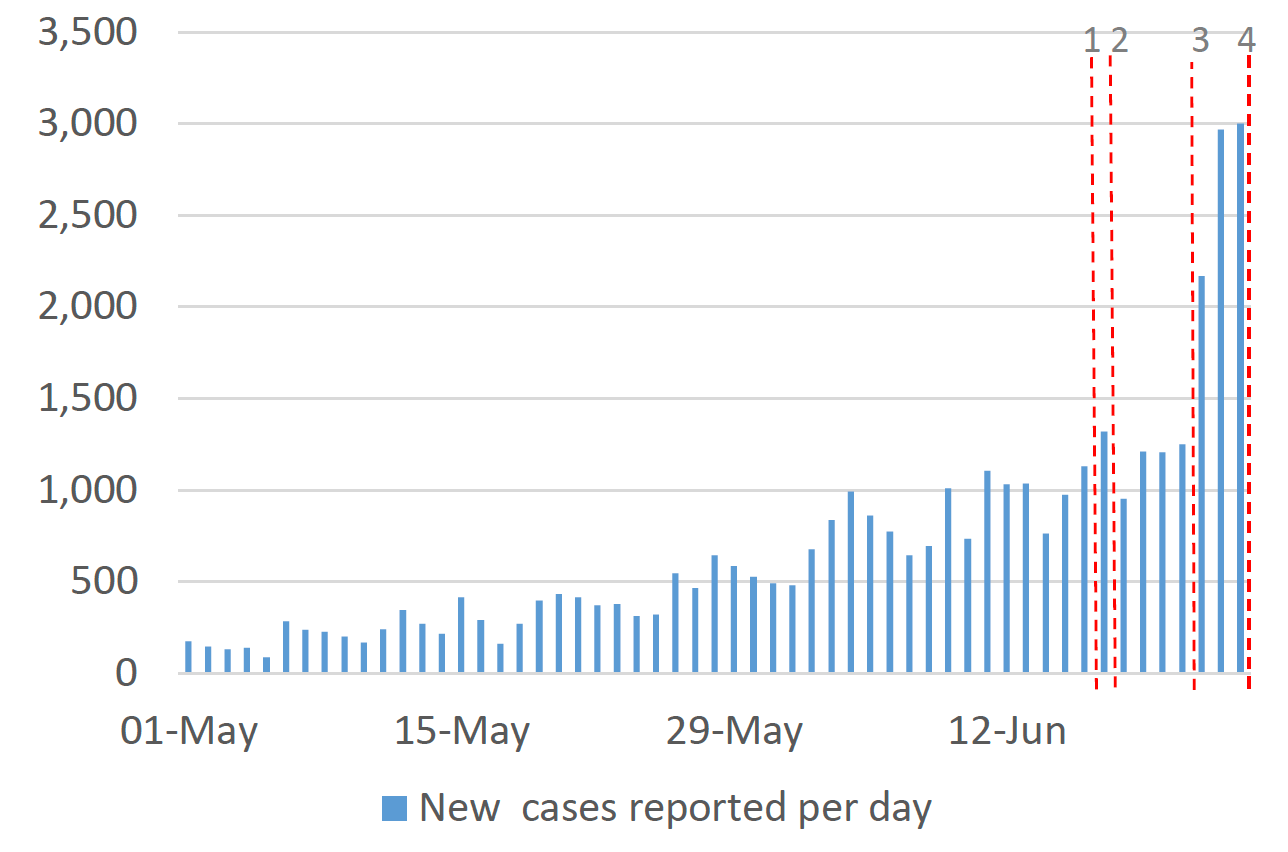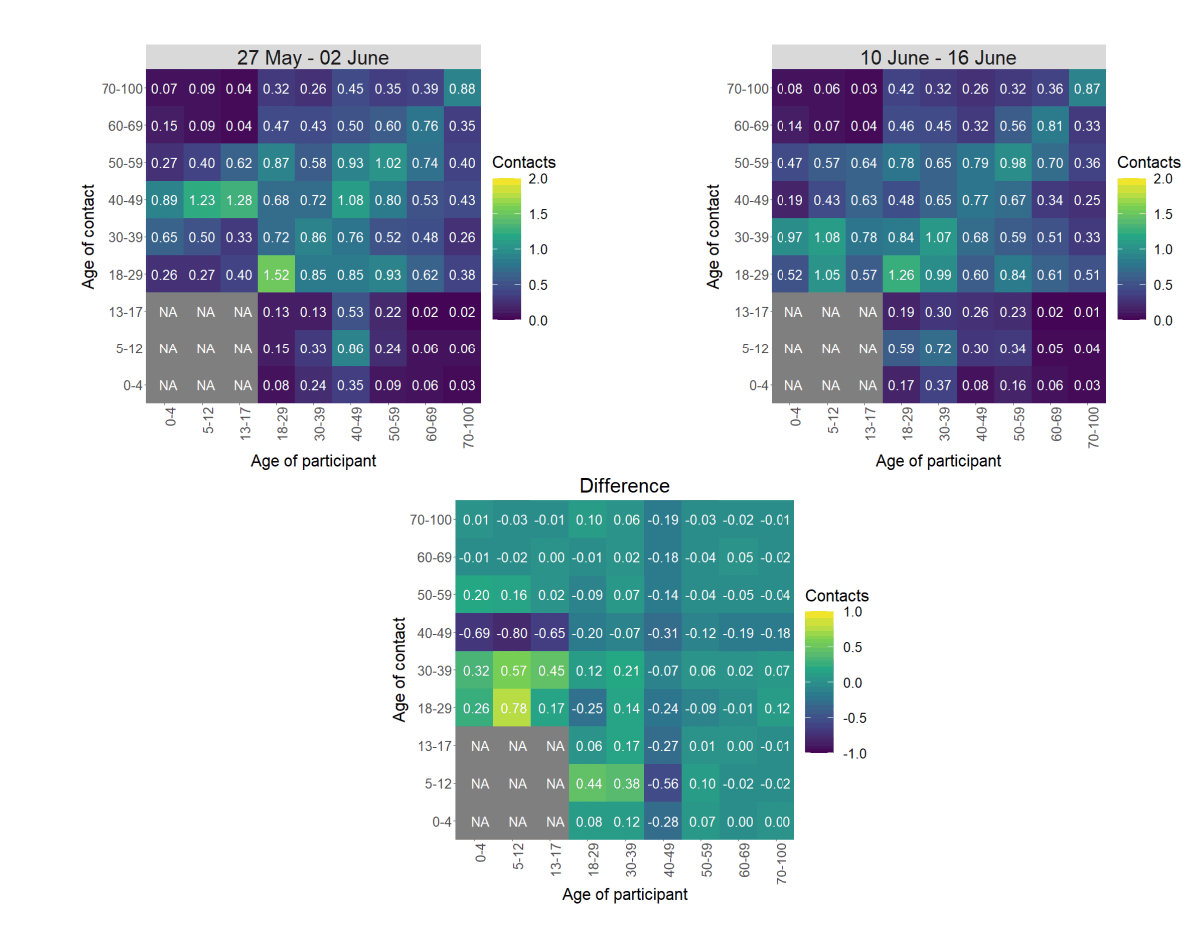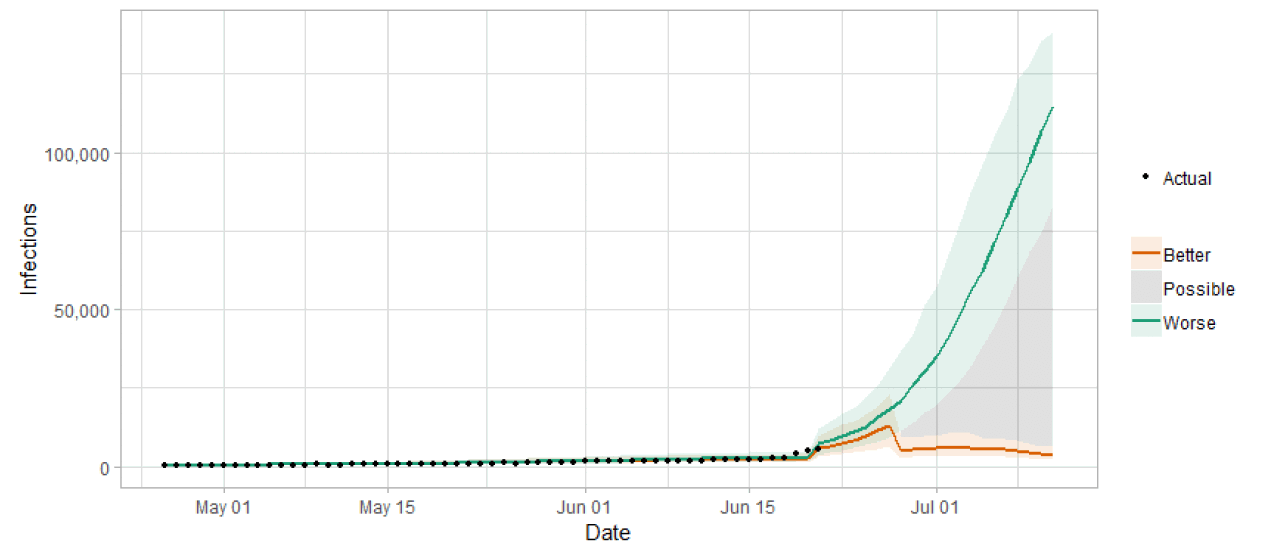Coronavirus (COVID-19): modelling the epidemic (issue no. 57)
Latest findings in modelling the COVID-19 epidemic in Scotland, both in terms of the spread of the disease through the population (epidemiological modelling) and of the demands it will place on the system, for example in terms of health care requirement.
Coronavirus (COVID-19): modelling the epidemic in Scotland (Issue No. 57)
Background
This is a report on the Scottish Government modelling of the spread and level of Covid-19. This updates the previous publication on modelling of Covid-19 in Scotland published on 17 June 2021. The estimates in this document help the Scottish Government, the health service and the wider public sector plan and put into place what is needed to keep us safe and treat people who have the virus.
This edition of the research findings focuses on the epidemic as a whole, looking at estimates of R, growth rate and incidence as well as local measures of change in the epidemic.
In Scotland, the modelled estimate for R is between 1.1 and 1.3, with the growth rate between 2% and 4% based on the period up to 21st June before the increase in cases seen in recent days. Based on the most recent increase in cases, infections, hospital beds and ICU are projected to rise – how long this continues for is uncertain.
Following the recent increase in cases, we are projecting a growth in the epidemic in Scotland, with considerable uncertainty as to what this means for future weeks.
Key Points
- The reproduction rate R in Scotland is currently estimated as being between 1.1 and 1.3, based on the period up to 21st June.
- The number of new daily infections for Scotland is estimated as being between 50 and 63, per 100,000 people, based on the period up to 21st June.
- The growth rate for Scotland is currently estimated as being between 2% and 4%, based on the period up to 21st June.
- Average contacts have remained at a similar level in the last two weeks (comparing surveys pertaining to 27th May - 2nd June and 10th June - 16th June) with a current level of 4.3 daily contacts.
- Contacts within the work setting have decreased in the last two weeks by 18% whereas contacts within the school setting have increased by 78%. Contacts within the home and other setting (contacts outside of home, school and work) have remained at similar levels over the same period.
- Those aged under 40 increased their overall contacts. This was largely driven by a rise in contacts within the other and school setting for those aged between 18-29 and by a rise in contacts within the other and work setting for those aged between 30-39.
- The biggest increase in interactions is seen with those aged between 18-39 with those aged under 18 whereas those aged between 40-49 have reported the biggest reductions in interactions with those under 18.
- The biggest increase in the proportion of participants visiting different locations, though slight, is seen in those visiting another's home and also those attending an outside event. Visits to another's home have increased from approximately 48% to 51% with individuals attending an event outside increasing from 69% to 72% in the last two weeks.
- Based on the recent increase in cases, infections, hospital beds and ICU are projected to rise – how long this continues for is uncertain.
- Modelled rates of positive tests per 100K using data to 21st June indicate that for the week commencing 4 July 2021, there are 27 local authorities with at least a 75% probability of exceeding 50 cases. Of these, 25 local authorities have at least a 75% probability of exceeding 100 cases and 6 (Edinburgh, Dundee, East Ayrshire, East Dunbartonshire, East Lothian and South Ayrshire) have at least a 75% probability of exceeding 300 cases. Note that this work was undertaken prior to the most recent uptick in cases and is therefore likely to be an underestimate.
- The level of wastewater Covid-19 shows a continued increase up until the 17th June. However the recent step change showing a pronounced increase in cases is not currently presented in this analysis due to sampling dates. The impact of this will be shown next week when more data becomes available.
Recent increase in cases
Figure 1 shows the number of cases reported in Scotland during May and June 2021, including the recent increase in cases seen in the last few days. The vertical dashed lines indicate the cut off points for each of the modelling inputs; after these dates, the number of cases is not incorporated into the outputs. Models will be updated to reflect the recent increase in cases next week.

This report covers the period up to 16th June for contact patterns (indicated by dashed line 1). Wastewater data is provided to 17th June (dashed line 2). The estimates of R, incidence, growth rates, and for the modelled rates of positive tests per 100k use data to 21st June (dashed line 3). Medium term projections by the Scottish Government of infections, hospitalisations and ICU beds have been calculated using data to 24th June based on date reported (dashed line 4).
Overview of Scottish Government Modelling
Modelling outputs are provided here on the current epidemic in Scotland as a whole, based on a range of methods. Because it takes a little over three weeks on average for a person who catches Covid-19 to show symptoms, become sick, and either die or recover, there is a time lag in what our model can tell us about any re-emergence of the epidemic and where in Scotland this might occur.
However modelling of Covid-19 deaths is an important measure of where Scotland lies in its epidemic as a whole. In addition, the modelling groups that feed into the SAGE consensus use a range of other data along with deaths in their estimates of R and the growth rate. These outputs are provided in this research findings. The type of data used in each model to estimate R is highlighted in Figure 1.
We use the Scottish Contact Survey (SCS) to inform a modelling technique based on the number of contacts between people. Over time, a greater proportion of the population will be vaccinated. This is likely to impact contact patterns and will become a greater part of the analysis going forwards.
The logistical model utilises results from the epidemiological modelling, principally the number of new infections. The results are split down by age group, and the model is used to give a projection of the number of people that will go to hospital, and potentially to ICU. This will continue to be based on both what we know about how different age groups are affected by the disease and the vaccination rate for those groups.
What the modelling tells us about the epidemic as a whole
The various groups which report to the Scientific Pandemic Influenza Group on Modelling (SPI-M) use different sources of data in their models (i.e. deaths, hospital admissions, cases) so their estimates of R are also based on these different methods. The delay between infection, the need for hospital care, and death means R and growth rate estimates are lagged by two to three weeks.
SAGE's consensus view across these methods as of 23rd June, using data to 18th June, was that the value of R in Scotland was between 1.1 and 1.3 (see Figure 2)[1]. This is based on data before the recent increase in cases.
This week the Scottish Government presented two outputs to SPI-M. The first uses confirmed cases as published by Public Health Scotland (PHS). The second uses instead wastewater data to estimate the number of cases. Both outputs are shown in Figures 2 and 3.

Source: Scientific Advisory Group for Emergencies (SAGE).
The various groups which report to the Scientific Pandemic Influenza Group on Modelling (SPI-M) use different sources of data in their models to produce estimates of incidence (Figure ). SPI-M's consensus view across these methods, using data to 21st June, was that the incidence of new daily infections in Scotland was between 50 and 63 new infections per 100,000. This equates to between 2,700 and 3,400 people becoming infected each day in Scotland. This estimate was produced before the most recent increase in cases.

Source: Scientific Pandemic Influenza Group on Modelling (SPI-M).
The consensus from SAGE for this week is that the growth rate in Scotland is between 2% and 4% per day using data to 21st June.
What we know about how people's contact patterns have changed
Average contacts have remained at a similar level in the last two weeks (comparing surveys pertaining to 27th May - 2nd June and 10th June - 16th June) with a current level of 4.3 daily contacts as seen in Figure 4. Contacts within the work setting have decreased in the last two weeks by 18% whereas contacts within the school setting have increased by 78%. Contacts within the home and other setting (contacts outside of home, school and work) have remained at similar levels over the same period.

Figure 5 shows how contacts change across age group and setting. Those aged under 40 increased their overall contacts. This was largely driven by a rise in contacts within the other and school setting for those aged between 18-29 and by a rise in contacts within the other and work setting for those aged between 30-39. Individuals 40 and over reported a decrease in mean contacts.

The heatmaps in Figure 6 show the mean overall contacts between age groups for the weeks relating to 27th May - 2nd June and 10th June - 16th June and the difference between these periods. The biggest increase in interactions is seen with those aged between 18-39 with those aged under 18 whereas those aged between 40-49 have reported the biggest reductions in interactions with those under 18.

The biggest increase in the proportion of participants visiting different locations, though slight, is seen in those visiting another's home and also those attending an outside event as seen in Figure 7. Visits to another's home have increased from approximately 48% to 51% with individuals attending an event outside increasing from 69% to 72% in the last two weeks.

Vaccinations and contacts patterns
From Figure 8, it can be seen that the older age groups have fewer contacts and more vaccinations than the younger age groups, they also have the lowest weekly case number comparatively to the younger age groups. Despite that, they have similar weekly hospitalization levels to that seen with the younger age groups.

What the modelling tells us about estimated infections as well as Hospital and ICU bed demand
The Scottish Government assesses the impact of Covid-19 on the NHS in the next few weeks in terms of estimated number of infections. Figure 9 shows two projections. 'Worse' is based on a sustained increase in transmission rate at a level that could have caused the recent increase in cases. 'Better' is based on that increase being short-lived, and transmission rate drops to last week's levels after one week[5].

There is uncertainty as to whether infections will continue to rise or will reduce in coming weeks. This will drive whether hospital beds and intensive care beds also continue to rise.
Figure 10 shows the impact of the projections on the number of people in hospital. The modelling includes all hospital stays, whereas the actuals only include stays up to 28 days duration that are linked to Covid-19. Work is ongoing to show the modelled occupancy for stays up to a 28 day limit.
The increase in cases seen in the last few days is likely to lead to an increase in hospitalisations and intensive care use, with considerable uncertainty as to future weeks.

Figure 11 shows the impact of the projection on ICU bed demand.

A comparison of the actual data against historical projections is included in the Technical Annex.
What we know about which local authorities are likely to experience high levels of Covid-19 in two weeks' time
We continue to use modelling based on Covid-19 cases and deaths using data to 21st June from several academic groups to give us an indication of whether a local authority is likely to experience high levels of Covid-19 in the future. This has been compiled via SPI-M into a consensus. In this an area is defined as a hotspot if the two week prediction of cases (positive tests) per 100K population is predicted to exceed a threshold, e.g. 500 cases. Please note that this work was undertaken prior to the most recent uptick in cases and is therefore likely to be an underestimate.
Modelled rates of positive tests per 100K using data to 21st June (Figure 12) indicate that for the week commencing 4 July 2021, there are 27 local authorities with at least a 75% probability of exceeding 50 cases. Of these, 25 local authorities have at least a 75% probability of exceeding 100 cases and 6 (Edinburgh, Dundee, East Ayrshire, East Dunbartonshire, East Lothian and South Ayrshire) have at least a 75% probability of exceeding 300 cases[8].

What can analysis of wastewater samples tell us about local outbreaks of Covid-19 infection?
Levels of Covid-19 RNA in wastewater collected at a number of sites around Scotland are adjusted for population and local changes in intake flow rate and compared to daily 7-day average positive case rates derived from Local Authority and Neighbourhood (Intermediate Zone) level aggregate data[9].
The level of wastewater Covid-19 shows a continued increase up until the 17th June. However the recent step change showing a pronounced increase in cases is not currently presented in this analysis due to sampling dates. The impact of this will be shown next week when more data becomes available.
Figure 13 shows the national aggregate for the original 28 sites with long-term records (in blue) and, from January 2021, the aggregate for the full set of up to 110 currently sampled sites (in green)[10]. This aggregate shows a continued rise in WW Covid-19 to around 18-19 million gene copies/person/day (Mgc/p/d).
The WW signal is slightly lower this week than the cases, but continues to rise. The reason for WW being lower than cases over the last week is being explored.

What next?
The Scottish Government and other academic modelling groups will be working over the next few days to further understand the impact of the recent change in cases in Scotland on the course of the epidemic.
The modelled estimates of the numbers of new cases and infectious people will continue to be provided as measures of the epidemic as a whole, along with measures of the current point in the epidemic such as Rt and the growth rate. Further information can be found at https://www.gov.scot/coronavirus-covid-19.
We may report on exceedance in future weeks when the background levels of Covid-19 reduces so that it can be useful in identifying outbreaks.
Contact
There is a problem
Thanks for your feedback